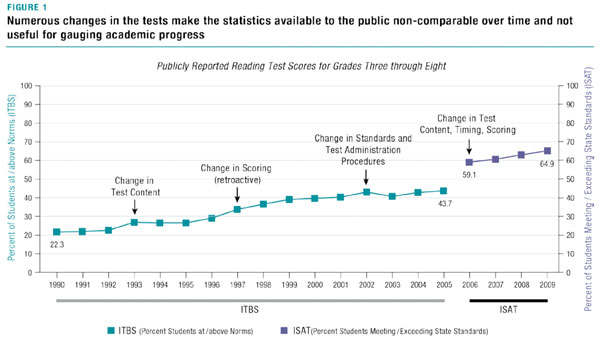
This year's Illinois school "report cards" are out, and elements of it are pretty confusing; for instance, the way high-school graduation rates are calculated has completely changed:
Under Illinois' old formula, for example, the state divided the number of high school graduates in a given year by the number of first-time ninth-graders four years earlier, also taking into consideration student transfers. But the graduates in the equation weren't necessarily in that ninth-grade class four years earlier — they could have been in high school for five or more years.
The new formula also divides graduates by first-time ninth-graders, but it creates a "cohort" of freshmen who are tracked through high school and must graduate four years later to be counted in a school's graduation rate.
These changes have been going around, and other states have been seeing similar drops in graduation rates under the new formula:
States that converted to the new formula already have seen drops ranging from modest to massive. Michigan had a nearly 10 percentage point fall when it made the switch in 2007. About half of states are not yet using the new calculation.
[snip]
States making the switch this year are offering estimates of expected dips and discussing the change in school board meetings. In Kansas, the graduation rate is expected to tumble from 89 percent to 80 percent, with one district in the state anticipating a 20-point drop. Georgia said its overall rate — now at 80 percent — could plummet about 15 percentage points.
Opaque enough? There's more. WBEZ education reporter Linda Lutton talked to Stuart Luppescu, chief psychometrician at the Consortium of Chicago School Research, and he was highly critical of the public data on how many students meet standards: "Misleading, inaccurate, and sends the wrong message to the public." Luppescu and his co-authors expanded on this a great deal in their September report, "Trends in Chicago Schools Across Three Eras of Reform" (PDF). For instance:

Every year the numbers come out, and I end up scratching my head, for reasons like that. But I did read one promising piece: "'Looping' Pairs Students, Teachers For Years," by the Sun-Times's Rosalind Rossi, which focuses on the successful low-income Chopin Elementary School in West Town/Ukrainian Village/Humboldt Park (the Trib's full report card is here). It's about the school's method of "looping," which just means keeping students with the same teachers for multiple years. It's an old method—dating back not just to the one-room schoolhouses of yore but also to the beginnings of Waldorf education—and something I had some experience with as an alternative-school-educated kid. It's not widely practiced in the U.S., but it does exist:
There is little hard data on the frequency or effectiveness of looping, but classes in hundreds, if not thousands of schools across the United States have adopted it.
[snip]
It is most common in elementary schools, though some middle schools do it, too. Schools in Colorado Springs have tried looping, as have those in Attleboro, Mass., and Antioch, Ill. In New York City, hundreds of classes stay together for more than a year, most of them in the lower grades.
As almost everything I've read on it notes, it makes a lot of intuitive sense: teachers don't have to give up students so soon after they've figured out their personalities, learning styles, and habits, and they can go into their second year with a solid grasp of their students. And since everyone knows they're all in the same boat for at least two years if not more, there's more incentive on both sides of the equation to make the student-teacher relationship work
But as that New York Times article notes, there's not a lot of hard data on looping, in part because it's so uncommon. But what's out there is, from what I can determine, positive. The PhD thesis "Long-term effects of looping on the transition to middle school" provides a good overview of the literature. Among other things, there are good arguments for it in a school like Chopin:
A multiyear relationship enabled the development of a strong support system for children, which was considered critical to countering the negative effects that many children experience through change of residence, family structure, or economic status (Hanson, 1995). Haslinger (1996) cited the benefits looping had for immigrant families. It offered the immigrants an extended period of time to become comfortable with their teachers and adjust to a new school environment. When there was a sense of community, confidence resulted that permitted the sharing of customs and stories from their countries. The rapport which developed among the children and teacher further eliminated stereotypes.
[snip]
Lincoln (1997), a teacher at Tolland Middle School in Connecticut, wrote that stability in the middle school years was more important than at any time in the students’ academic years. With the weakening of adult-child relationships in today’s society due to conditions such as single parents, blended families, and families where both parents work, the looping model provided an additional measure of stability by building stronger relationships between students and teachers. In the looping classes at Tolland Middle School, eighth grade students earned higher grades in language arts than did the nonlooping classes. The state writing competency scores increased from 41% in the sixth grade looping classes to 79% in the eighth grade.
Or, from a 2004 RAND survey of middle-school pedagogy (PDF):
A limited number of studies attest to the benefits. Comparing the social relations and academic achievement of middle school students in looped and nonlooped classes, Lincoln (1998) found that looped classes had advantages with respect to test scores, self-efficacy, and attitudes toward schools. Similarly, Grant (2000) reported on a Massachusetts district that used looping for students in 1st through 8th grades. Research over a seven-year period found that, after the implementation of looping, student attendance and retention rates increased, disciplinary actions and suspensions decreased, and staff attendance improved. Thus, based on a very limited research base, looping appears to be another promising practice. How well this practice would be implemented across many schools on a larger scale is not known.
Among the obvious disadvantages is that teachers have to be familiar with more than one grade's worth of material and methods for teaching it. In my obviously limited experience, this wasn't a problem; in fact, the teacher who did the best job at cracking through my fear of an inability to do math was a biology teacher forced into a stint teaching geometry. Having to refamiliarize himself with the material meant that he didn't instinctually take parts of it for granted, and had a more vivid sense of the potential roadblocks for learners.
In short, looping means trading some familiarity with subject matter for familiarity with students. The literature is thin, but there are suggestions it's a worthwhile trade.
Photograph: Robert S. Donovan (CC by 2.0)


